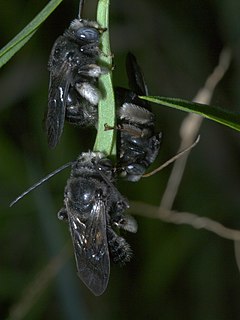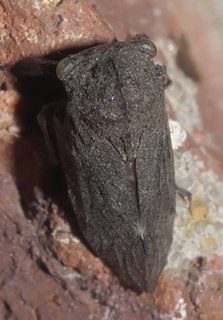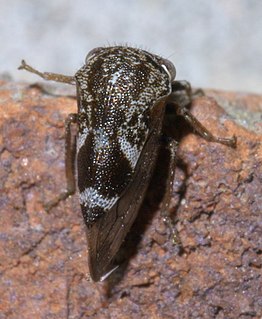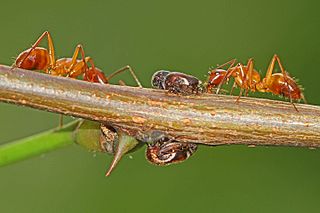
Treehoppers and thorn bugs are members of the family Membracidae, a group of insects related to the cicadas and the leafhoppers. About 3,200 species of treehoppers in over 400 genera are known. They are found on all continents except Antarctica; only five species are known from Europe. Individual treehoppers usually live for only a few months.

The buffalo treehopper is a species of treehopper belonging to the subfamily Membracinae. It is also sometimes classified as Ceresa bisonia.

Entylia is a genus of treehoppers in the family Membracidae. There are at least three described species in Entylia.

Entylia carinata, commonly known as the keeled treehopper, is a species of treehopper in the family Membracidae. It is found in Brazil, Panama, Mexico, the United States, and Canada. Keeled treehoppers are often attended by ants which feed on the honeydew excreted by the treehoppers. In return, the ants offer protection from predators. Keeled treehoppers typically feed on plants in the aster family. They are not known to transmit plant diseases and are not considered significant plant pests.

Melissodes bimaculatus, the two-spotted longhorn, is a species of long-horned bee in the family Apidae.

Microcentrus caryae, the hickory stegaspidine treehopper, is a species of treehopper in the family Membracidae.

Microcentrus is a genus of treehoppers in the family Membracidae. There are about 10 described species in Microcentrus.

Smiliinae is a subfamily of treehoppers in the family Membracidae. These are bugs and include about 100 genera in 10 tribes.

Ophiderma salamandra is a species of treehopper in the family Membracidae.

Polyglypta is a genus of treehoppers in the family Membracidae. There are at least three described species in Polyglypta.

Telamona excelsa is a species of treehopper in the family Membracidae.

Telamona is a genus of treehoppers in the family Membracidae. There are at least 30 described species in Telamona.

Telamonini is a tribe of treehoppers in the family Membracidae. There are about 9 genera and at least 50 described species in Telamonini.

Thelia is a genus of treehoppers in the family Membracidae. There are at least two described species in Thelia.

Thelia uhleri is a species of treehopper in the family Membracidae.

Tylopelta gibbera is a species of treehopper in the family Membracidae.

Tylopelta is a genus of treehoppers in the family Membracidae. There are at least four described species in Tylopelta.

Vanduzea arquata, the black locust treehopper, is a species of treehopper in the family Membracidae.

Vanduzea is a genus of treehoppers in the family Membracidae. There are about 12 described species in Vanduzea.

The Brazilian treehopper is a species of insect belonging to the treehopper family (Membracidae). It has unusual helicopter-like features. While Bocydium can be found throughout the world, they are most prevalent in Africa, North and South America, Asia and Australia. They exhibit limited movement and their primary food source is from the underside of leaves. They also exhibit hemimetabolous development.
















